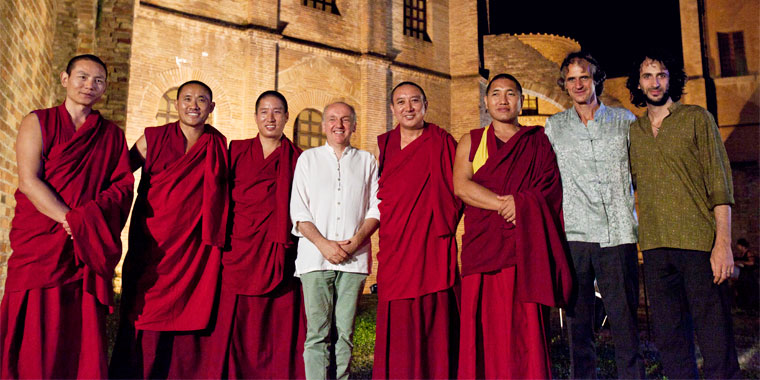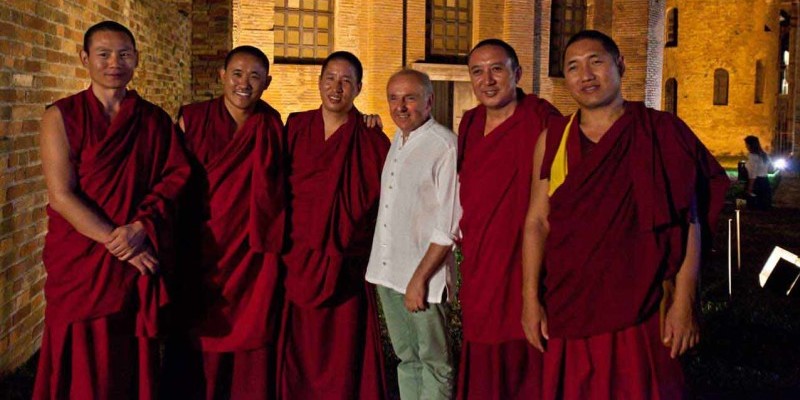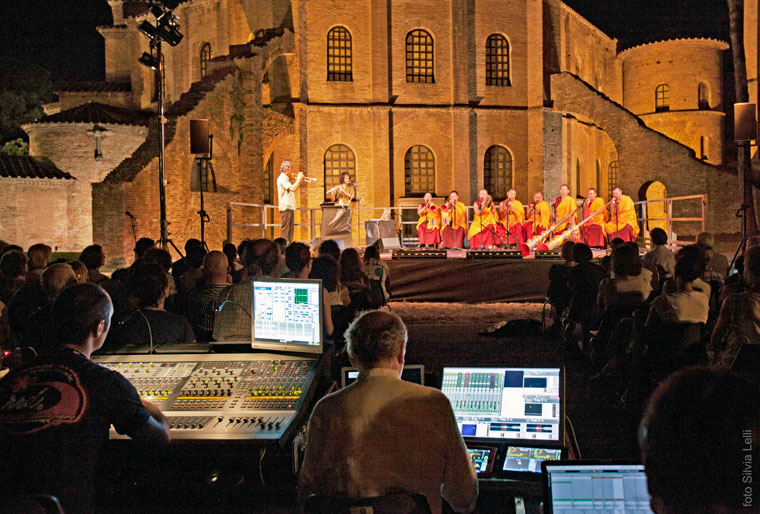Tibetan chants of the Drepung Loseling Monastery and live electronics
duration 20′
Ravenna Festival 2012
1st performance: Ravenna, Ravenna Festival, Tibetan Monks Inside Electronics, Giardini della Basilica di San Vitale – July 10, 2012, 9:30 p.m.
.
photos by Silvia Lelli
We westerners should seek the keys for penetrating into the secrets of Tibetan music beyond the charm of the exotic and mysticism, which undoubtedly captivate us from the very first moment. The harmonic, melodic, rhythmic and temporal conceptions of the chants of Tibetan monks are very far from Western musical culture. These songs seem rather static and monotonous to us, but within them there is a very rich ever-changing world, and a continuous micro-variation of all the musical elements that gives the sound all the substance of a living organism. The movement of each note is independent for each voice and for each sound, so that each has its own distinct individuality but at the same time everything is tied together.
In Tibetan music, as in all non-European cultures, harmony is not constructed upon laws of symmetry between consonance and dissonance, but upon the structure of the timbre of the sound, which sometimes creates a complex and inextricably intermixed

magma of unisons, or near-unisons because it is precisely the microtonal differences that make these sounds so fascinating. Also the tempo is never organized into regular subdivisions and the pulsations of the percussions are never synchronous. Their flow is like the water of a river, which, although the water is going in a precise direction, every drop that is a part of it has its own individual course and direction.
My electroacoustic intervention upon Tibetan chants is not an attempt to take exotic sounds and adapt them to Western sensibilities. But it more simply – or perhaps in a more complex way if you look at it from another angle – intends to expand the characteristics of this music by means of digital technology, thereby making its modalities and its microstructures more evident.
This is done by means of much the same kind of modulation of the voice that Tibetans themselves use in their chanting, such as the phase shifting of the high notes and the accentuation of the harmonic components, which is a procedure that gives predominance to the timbre of the sound.
Mine is a personal intervention that certainly alters the tradition, but it is above all an attempt to come closer to this music, making it as explicit as possible, while maintaining an attitude of respect and careful attention to the original values. In the chanting of the monks the melodic lines do not differ only in the differences of the intervals, but at the same time they proceed inexorably with a slow upward movement of the frequencies.
This is not an occasional characteristic, but it is almost always found in the chants and in some monophonic recitatives. This music always starts off from the deepest sound which the voice is able to produce, and then it climbs very gradually, exploring the greatest range of vocal possibilities. Sometimes this climb is broken by jumps backwards and then it is resumed, and sometimes it is continuous. This is an element that is almost unknown in our own musical culture, and only electronic music has allowed us to conceive of it as an expressive element and not simply as a mistake. This obsessive yearning to ascend, this continuous attempt to start from the deepest notes and rise to the most extremely heightened notes can be interpreted as the elevation of the chant or song and of the spirit itself above earthly things, but at the same time as an attempt to find a union between all things, whether they be high or low. These two apparently contradictory conceptions are among the greatest teachings of Buddhist philosophy.
Luigi Ceccarelli


